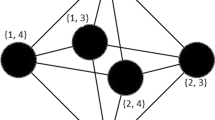Abstract.
We show that disjointness requires randomized communication \(\Omega(\frac{n^{1/(k+1)}}{2^{2^k}})\) in the general k-party number-on-the-forehead model of complexity. The previous best lower bound for k ≥ 3 was \(\frac{{\rm log} \, n}{k-1}\). Our results give a separation between nondeterministic and randomized multiparty number-on-the-forehead communication complexity for up to k = log log n − O(log log log n) many players. Also, by a reduction of Beame, Pitassi, and Segerlind, these results imply subexponential lower bounds on the size of proofs needed to refute certain unsatisfiable CNFs in a broad class of proof systems, including tree-like Lovász–Schrijver proofs.
Similar content being viewed by others
Author information
Authors and Affiliations
Corresponding author
Additional information
Manuscript received 2 September 2008
Rights and permissions
About this article
Cite this article
Lee, T., Shraibman, A. Disjointness is Hard in the Multiparty Number-on-the-Forehead Model. comput. complex. 18, 309–336 (2009). https://doi.org/10.1007/s00037-009-0276-2
Published:
Issue Date:
DOI: https://doi.org/10.1007/s00037-009-0276-2




